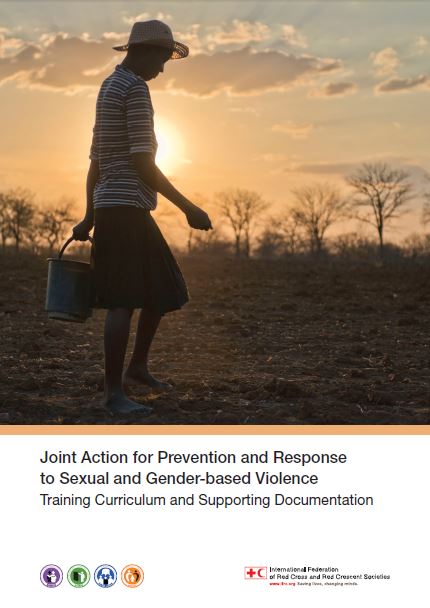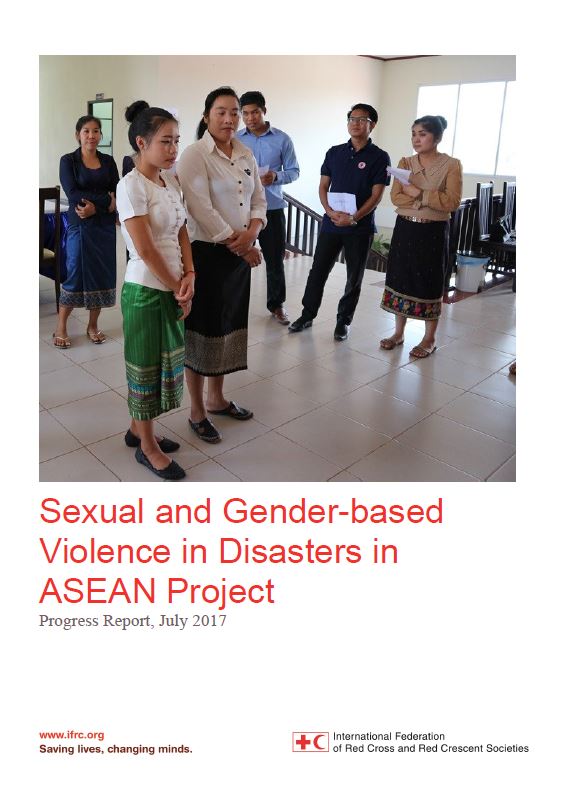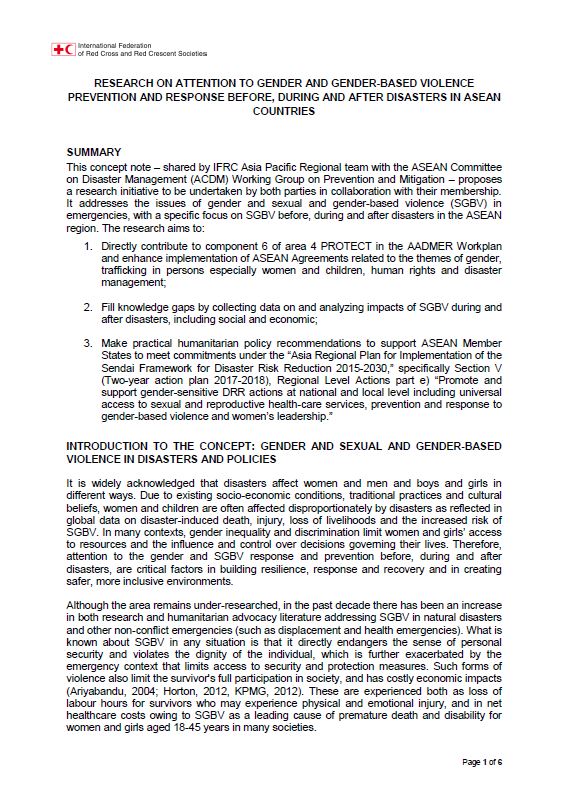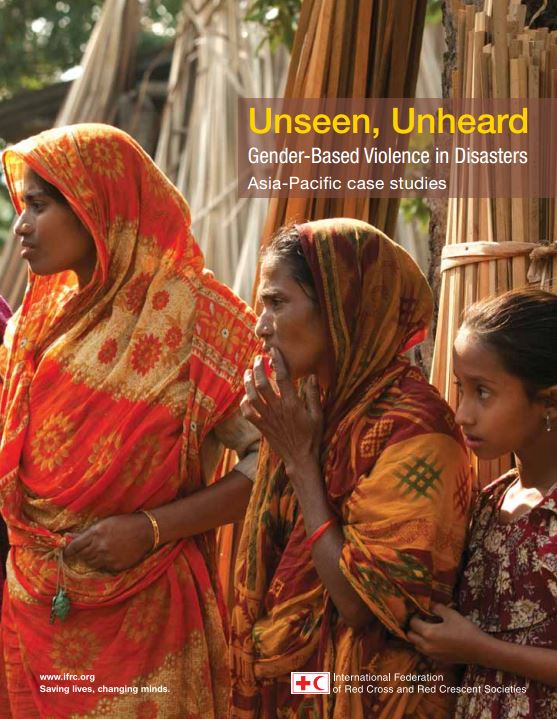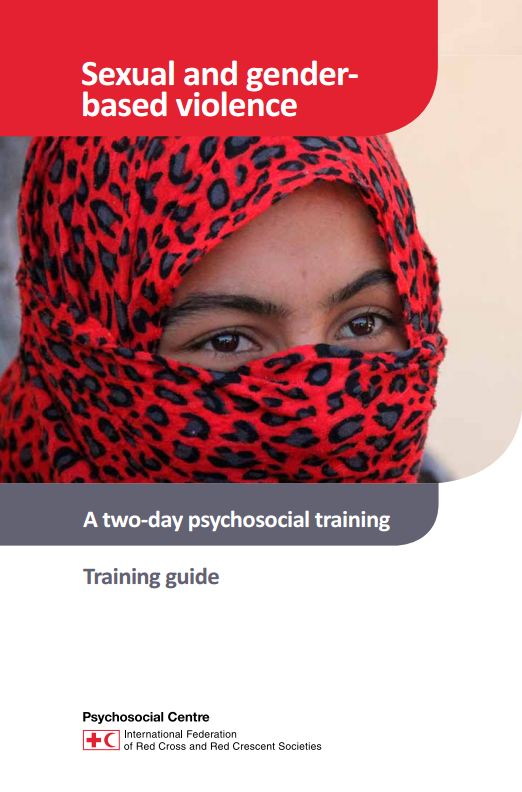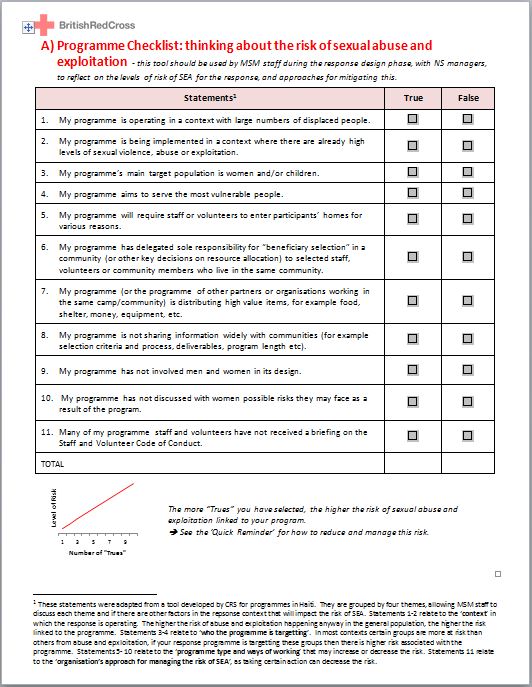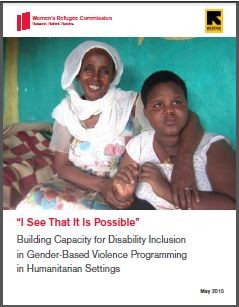Joint Action for Prevention and Response to Sexual and Gender-based Violence
This curriculum guide presents the information needed to run an introductory course on sexual and gender-based violence (SGBV) issues and programmatic interventions in humanitarian emergency response.
It contains the sample agenda, training modules and tools to provide a two and a half-day course (which can be amended to a longer course or a training of trainer module if needed). The target audience is the International Federation of Red Cross and Red Crescent Societies (IFRC) and National Society programme managers (health, disaster management, community services, etc.) and gender and diversity focal persons. It will help the target audience to integrate SGBV interventions into all areas of work with an emphasis on emergencies. The course has been developed as one of the actions set out in the Resolution on Sexual and Gender-based Violence passed by the 32nd International Conference in 2015.
![]()
ASEAN Consultation Meeting on SGBV Research | 2-3 May 2018 | Jakarta, Indonesia
The proposal to conduct the Joint Study on Gender Based Violence (GBV) in Disasters in ASEAN was endorsed by the ASEAN Committee on Disaster Management (ACDM) Working Group on Prevention and Mitigation in March 2017, and was subsequently endorsed at the 30th ACDM Meeting in Vientiane, Lao PDR in April 2017.
The joint study is implemented as part of the ASEAN Agreement on Disaster Management and Emergency Response (AADMER) Work Programme 2016-2020, Priority Programme 4: Protect, and covers Indonesia, Lao PDR and the Philippines. The study aims to better understand how public authorities and humanitarian actors can prevent and better respond to gender based violence during and after disasters. The research initiative, undertaken by IFRC, Lao Red Cross, Palang Merah Indonesia, Philippines Red Cross, and the ACDM Working Group on Prevention and Mitigation, was implemented in Indonesia, Lao PDR and the Philippines.
The inter-sectoral consultation meeting is being held during 2-3 May 2018 and bringing together IFRC and the following ASEAN bodies, namely, i) ASEAN Committee on Women (ACW); ii) the ASEAN Commission on the Promotion and Protection of Women and Childrens’ Rights (ACWC); and iv) the ACDM Working Group on Prevention and Mitigation.
The objectives of the consultation are to provide a platform for sharing of research methodology, presenting results, and developing recommendations on the issues to be addressed as well as way forward for promotion of the welfare and protection of the rights of women and girls in disasters at ASEAN level.
Meeting documents:
Presentations:
Remarks by Sharon Armstrong, Director and Counsellor (Development), Indonesia and ASEAN Programs Mission of Canada to ASEAN
Remarks by Giorgio Ferrario, IFRC CCST Jakarta
Remarks by Vilayphong Sisomvang, Ministry of Labor and Social Welfare, Lao PDR
Session 2:
- Regional Landscape on Promotion of Women&Children’s Right and Disaster Management
- GBV Prevention and Response During & After Disasters
- Research Linking SGBV Policy and Disaster Laws
Session 3:
Session 4:
Session 5:
- Red Cross Red Crescent Approaches to Social Protection
- Operationalising protection, gender and inclusion in emergency programming
- Gender Mainstreaming During Disaster
- Elimination of Violence Against Women and Children
![]()
Sexual and Gender-based Violence in Disasters in ASEAN Project Progress Report
The progress report details the progress of the research which has been initiated by IFRC with the ASEAN Committee on Disaster Management (ACDM) Working Group on Prevention and Mitigation in collaboration with their membership. It addresses the issues of gender and sexual and gender-based violence (SGBV) in emergencies, with a specific focus on SGBV before, during and after disasters in the ASEAN region.
The research aims to:
- Directly contribute to component 6 of area 4 PROTECT in the AADMER Workplan and enhance implementation of ASEAN Agreements related to the themes of gender, trafficking in persons especially women and children, human rights and disaster management;
- Fill knowledge gaps by collecting data on and analyzing impacts of SGBV during and after disasters, including social and economic;
- Make practical humanitarian policy recommendations to support ASEAN Member States to meet commitments under the “Asia Regional Plan for Implementation of the Sendai Framework for Disaster Risk Reduction 2015-2030,” specifically Section V (Two-year action plan 2017-2018), Regional Level Actions part e) “Promote and support gender-sensitive DRR actions at national and local level including universal access to sexual and reproductive health-care services, prevention and response to gender-based violence and women‟s leadership.”
![]()
Concept note SGBV research project
This concept note – shared by IFRC Asia Pacific Regional team with the ASEAN Committee on Disaster Management (ACDM) Working Group on Prevention and Mitigation – proposes a research initiative to be undertaken by both parties in collaboration with their membership. It addresses the issues of gender and sexual and gender-based violence (SGBV) in emergencies, with a specific focus on SGBV before, during and after disasters in the ASEAN region.
![]()
Unseen, Unheard: Gender-Based Violence in Disasters. Asia Pacific case studies
Purpose
This report follows on from the global study Unseen Unheard: gender based violence in disasters which saw research being conducted in 9 countries globally, and included Bangladesh, Myanmar and Samoa from the Asia Pacific region. The Asia Pacific case studies provide an overview of gender-based violence (GBV) within each country context, as well as presenting findings and key recommendations with regards to 1) Awareness and understanding on GBV occurrence during disasters; 2) Availability and access to services; 3) Safety and security and; 4) Livelihoods and migration.
Overview
This report features three case studies from that study, each from Asia-Pacific:
- The first is from Bangladesh, a country with a legacy of cyclical disasters, including cyclones, floods and landslides. The study finds that some of the primary needs among those affected by cyclones include safe shelter settings for women and girls and, in particular, pregnant women, in order to prevent and reduce the risks of GBV.
- The second case study is from Samoa. In the aftermath of the 2009 Tsunami and 2012 Cyclone Evan, survivors reported GBV in shelters created for people displaced by the disasters. They also told us of an increase in domestic violence following the disasters.
- The third case study is from Myanmar, and looks at GBV occurrence and response after Cyclone Nargis in 2008. The results of this case study are interesting: half of respondents cited an increase in GBV after the cyclone, while others claimed that it did not arise at all because of strong family and community-based support systems. Such a puzzle may point to the culture of silence that surrounds GBV.
Usage: Policy reference and learning from experience
Audience: National Society staff, particularly gender and diversity practitioners.
See also: Resolution on “Sexual and gender-based violence: Joint action on prevention and response” which was adopted in December 2015 by the International Conference of the Red Cross and Red Crescent .This resolution was a direct outcome of the studies we undertook in Bangladesh, Samoa, Myanmar and elsewhere.
![]()
Sexual and Gender-based Violence: A Two-day Psychosocial Training
Purpose
This guide is a basic introduction to understanding sexual and gender-based violence (SGBV) in a psychosocial context. It provides information about different types of SGBV, as well as practical guidance on psychosocial support related to SGBV. It also provides participants with skills and knowledge on how to handle disclosures of SGBV and how to provide psychosocial support to people affected by SGBV.
Overview
- SGBV occurs when there are natural disasters and forced displacements and in conflict situations. It can also take the form of domestic violence and child abuse.
- The impact of SGBV can be divided into: psychological consequences; social consequences; physical consequences; consequences specific to female survivors and consequences specific to male survivors.
- Support people may need, whether at times of crisis, at an early stage of reconstruction or in situations of distress experienced by people over many years include: basic services and security; community and family support; focused non-specialised support and specialised services.
- Principles of the survivor-centred approach include: the principle of safety; the principle of confidentiality; the principle of respect and the principle of non-discrimination.
Usage: Training
Audiences: Technical staff, Gender and diversity practitioners
Reference: International Federation of Red Cross and Red Crescent Societies Reference Centre for Psychosocial Support (2015). Sexual and Gender-based Violence: A Two-day Psychosocial Training. Training guide (pp. 1-64). Available from: http://pscentre.org/wp-content/uploads/SGBV-A-two-day-psychosocial-training-final-version.pdf [Accessed: 24 December 2015].
![]()
Prevention of Sexual Abuse and Exploitation (PSEA) Emergency Programme Checklist and Quick Reminder
Purpose:
This document provides a checklist for the response design phase of a programme to enable reflection on the risk of Sexual Exploitation and Abuse (SEA), and approaches for mitigating this. It also provides guidance on minimising harm linked to Red Cross presence through PSEA.
Overview
No staff or volunteers shall: commit any act of sexual exploitation, sexual abuse or sexual violence; engage in any sexual activity with persons (adult or child) that look to or benefit from assistance; exchange money, employment, goods or services for sex, or sexual favours; engage in any acts which could be considered harassment, abuse, discrimination or exploitation.
Managers’ responsibilities include ensuring all staff and volunteers are: aware of all people involved in project activities; are briefed on a staff and volunteer Code of Conduct and sign it; explain this code of conduct to others; and know their roles and responsibility as part of this. Managers should also inform beneficiaries and community members about: their right to be protected from abuse and exploitation by staff and volunteers; what conduct they can expect from staff and how to raise concerns; programme activities, entitlements and targeting processes. Finally, they should design and implement programmes through a PSEA lens and ensure community and staff reporting options are in place.
Usage: Guidance for project implementation
Audiences: Technical staff, Gender and diversity practitioners, Volunteers
Reference: British Red Cross (2013). Prevention of Sexual Exploitation and Abuse (PSEA) Emergency Programme Checklist and Quick Reminder for Managers, (pp. 1-2).
![]()
“I see that it is Possible” Building Capacity for Disability Inclusion in Gender-Based Violence Programming in Humanitarian Settings
Purpose
This report documents the key findings and lessons learned from a project the International Rescue Committee (IRC) and the Women’s Refugee Commission (WRC) conducted to identify the barriers that people with disabilities face in accessing programmes and services designed to prevent and respond to GBV, and to pilot and evaluate solutions for promoting disability inclusion in Gender-Based Violence (GBV) programmes in conflict-affected settings. It concludes with practical recommendations for a range of humanitarian actors, governments and donors to improve disability inclusion in GBV programming in humanitarian settings.
The project was conducted in conflict-affected communities in Burundi, Ethiopia, Jordan and the Northern Caucasus in the Russian Federation.
Overview
- Negative attitudes and discrimination by GBV service providers, family and community members prevented access to GBV prevention activities and response services.
- Inadequate transportation to activity locations and service centres, and lack of use of appropriate communication approaches by GBV practitioners, particularly for people who are deaf or with intellectual disabilities, also served as a barrier to access and participation.
- Caregivers of persons with disabilities report being excluded from activities as a result of being unable to leave the people they care for.
Usage: Learning from experience
Audiences: National Society leadership; Technical staff; Gender and diversity practitioners
Parts of this report: the full report, 2-pager summary and toolkit
Reference: Women’s Refugee Commission (May 2015). “I see that It Is Possible” Building Capacity for Disability Inclusion in Gender-Based Violence Programming in Humanitarian Settings. Pp.1-41. Available from: https://www.womensrefugeecommission.org/resources/document/945-building-capacity-for-disability-inclusion-in-gender-based-violence-gbv-programming-in-humanitarian-settings-overview [Accessed: 18th July 2016].
![]()


